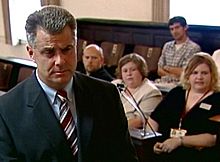Voir dire facts for kids
Voir dire (pronounced "vwah deer") is a special process used in courts. It's mainly used to choose the people who will be on a jury for a trial. It also helps make sure these jurors are fair and don't have strong opinions already. Sometimes, "voir dire" can also mean a quick, private talk between lawyers and a judge during a trial. The words "voir dire" come from an old French phrase meaning "to speak the truth."
Contents
History of Voir Dire
The idea of voir dire started a long time ago in Anglo-Norman times. It was an oath, like a promise, that jury members took to tell the truth. In the United States, the history of voir dire goes back to a law in Massachusetts in 1760.
Fair Jury Selection in Early America
Back then, British officials in the American colonies often put people on trial for criticizing British rule. To make sure these people were found guilty, the British government tried to pick only jurors who would agree with them. The local sheriff was in charge of choosing jurors. They would often pick people who supported the British king.
To make things fair, the 1760 Massachusetts law changed this. It said that a town meeting had to choose the list of possible jurors. In these public meetings, people could ask questions to see if anyone had strong opinions that would make them unfair. People on trial could also ask questions to potential jurors. This process helped make jury selection much fairer.
Changes and Independence
In 1774, the British Parliament (their government) canceled the Massachusetts law. This gave the British officials more power to choose jurors as they wished. However, just two years later, the Americans declared their independence. After that, the American system of voir dire developed to ensure fair trials for everyone.
Choosing Jurors in the United States
In the United States, voir dire is a key part of choosing a jury. Lawyers use this chance to find the best jurors for their client. This process can be quite detailed.
How Lawyers Pick Jurors
When potential jurors enter the courtroom, lawyers and their assistants (called paralegals) watch them closely. They pay attention to things like how people act and who they talk to. There's a lot of psychology involved in picking a jury. How a juror behaves can be just as important as their answers to questions.
Lawyers ask questions to understand how a potential juror thinks. For example, the kinds of books a person reads might show how they would decide a case. Lawyers try to give each juror individual attention. Their paralegals take careful notes. Things like eye contact, body language, and a person's general attitude are all watched closely during these interviews.
Dealing with Public Opinion
Voir dire is also used to remove jurors who might have been influenced by news stories about the trial before it starts. However, sometimes asking about these opinions can actually make jurors think more about them.
In other countries, like Australia and Canada, they handle pretrial news differently. Judges there can order people not to talk about the trial while it's happening.
Who Leads the Questions?
Judges have a lot of choices in how voir dire is done. In some courts, the judge asks all the questions. In other courts, the lawyers do all the questioning. Sometimes, it's a mix of both. Jurors are often more open and honest when answering questions from a lawyer than from a judge.
Voir Dire for Expert Witnesses
In some courts, lawyers can question expert witnesses before they give their testimony. An expert witness is someone who has special knowledge about a topic. This knowledge is usually much more than what an average person would know.
Sometimes, an expert witness might be stopped during their testimony for a voir dire. This happens if a lawyer wants to challenge whether the person is truly an expert. If the judge agrees that the challenge is successful, the judge can tell the jury to ignore what that expert said.
Voir Dire and Evidence
In the United Kingdom, voir dire is not used to pick juries. Instead, it's used to decide what evidence can be shown during a trial. This can include things like confessions made to the police.
In Australia and Canada, voir dire is like a "mini-trial" that happens inside the main trial. It's used to look at evidence. This usually happens when the jury is not in the courtroom. In Canada, voir dire can also be used to challenge a specific juror for a good reason. However, challenging a juror this way is rare in Canada.
See also
 In Spanish: Voir dire para niños
In Spanish: Voir dire para niños



